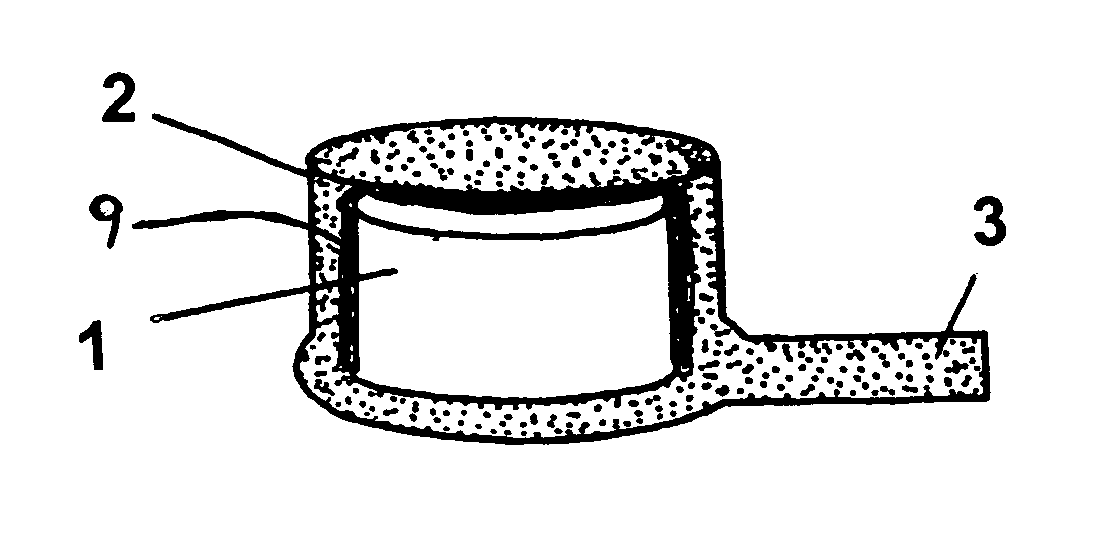However, in many instances such drugs are not capable of being administered either orally or intravenously without the risk of various detrimental side effects.
Continuous maintenance GCV therapy is necessary to prevent progression or recrudescence of the
disease, but despite
maintenance therapy a significant number of patients experience a relapse during treatment.
Additionally, there are other risks and problems associated with systemic GCV administration.
However, current treatment of CMV retinitis in
AIDS patients is clearly suboptimal.
Although delivering the drug locally with injections may minimize the
systemic toxicity of GCV, repeated injection is not a practical mode of administration.
However, these systems failed to achieve many of the advantages solved by later devices.
Multiple layer laminate systems can present a challenge to reproducibly manufacture and are more difficult to produce by large-scale or commercial manufacturing procedures.
While the capillary openings in this construction are effective for releasing certain drugs to the eye, they add considerable complexity to the manufacture of the device because it is difficult to control the size of these openings in commercial manufacturing using various polymers.
Nonetheless, as described in U.S. Pat. No. 4,014,335, certain problems have been identified with such devices such as the difficult task of sealing the margins of the membrane to form the container.
In addition, stresses and strains introduced into the membrane walls from deformation during manufacturing of those devices may cause the reservoir to rupture and leak.
However, there are many disadvantages associated with their use, including the fact that it is often difficult to obtain the desired release rate of the drug (either too much or too little drug is released into the body).
Further, it is difficult to adhere the device to the tab that is used to suture the device inside of the organ, such as an eye.
Great effort is expended to ensure a strong bond of the device to this “suture tab.” Even if the device is strongly adhered to the suture tab, it is a difficult task to completely seal all of the margins and prevent rupture and leaking of drug into the body.
While the devices described in U.S. Pat. No. 5,378,475 solve many of the aforementioned problems pertaining to
drug delivery, the devices and the method of making the devices are not without some problems.
In particular, polymers suitable for the second coating of the inner core are frequently relatively soft and technical difficulties can arise in production of uniform films that do not rupture and leak.
In such cases, relatively thick films must be applied to achieve uninterrupted and uniform coatings, which adds significant bulk to the device.
Thus, the devices tend to be larger than necessary as a result of the thickness needed to seal the ends of the inner core and seal it to the suture tab.
In addition to adding bulk,
multiple layer devices are more difficult to manufacture reproducibly and are more difficult to produce by commercial manufacturing procedures.
Also, the various
layers can be made of materials that are relatively incompatible with one another adding to the difficulties in coating.
Often devices such as these require a plurality of manual
assembly steps that is
time consuming, limits available supply, and adds variability.
While the third coating layer improves the
structural integrity of the device and helps to prevent potential leakage, some manufacturing difficulties can limit scaled up manufacturing.
For example, consistent application of the outermost coating layer and reproducibility in manufacturing can be problems with designs which require manual
assembly, a significant number of steps in the
assembly process, or outer dip coatings.
Larger devices require more complex
surgery to both
implant and remove.
The increased complexity can result in complication, longer healing or
recovery periods, and potential side effects (e.g. increased chance of
astigmatism).
Further, the extra
polymer required to achieve a uniform coating reduces the potential internal volume of the
implant and hence limits the amount of drug that can be delivered, potentially limiting both
efficacy and duration.
Also, failure of some of these devices in use can lead to a dumping of the agent, which can cause harm to the mammalian
organism being treated.
 Login to View More
Login to View More  Login to View More
Login to View More 

